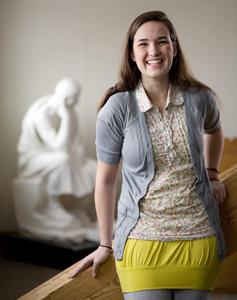December 22, 2008
When Bessie Young ’11, a double major in psychology and art and the history of art, registered for the college’s Collaborative Art course this past fall, she figured it would enable her to explore an interest of hers: how art impacts communities.
She had no clue how the class would impact her.
 Bessie Young ’11 compiled and edited a series of interviews with senior citizens for her final Collaborative Art project. |
Through it she met 80-year-old Peg, whose handmade jewelry and pottery have been featured in books and magazines. She learned about 83-year-old Dick, a retired professor who helped found and expand the polymer science program at the University of Massachusetts Amherst. There was also 84-year-old Daphne, who, in her “tumultuous” life, has been married several times and only sees her husband when he’s not working at a railroad office in Billerica, Mass., weekdays.
“I have this interesting group of senior citizen friends now, a whole other social circle apart from my college friends,” Young said. “It’s been such an amazing experience getting to know them.”
Young heard the stories of Peg, Dick, Daphne and a handful of other elderly town residents while creating a video for her final project for Collaborative Art, which matched students with people and groups in the area to create their own masterpieces.
She and the seven other students in the class, also undergraduates from Amherst, Hampshire College and UMass, were asked to identify and join forces with a community in the region on a project that “facilitated listening.” They worked with local children, workers, senior citizens and everyone in between to produce short films, audio segments and photo collages, among other things.
The projects involved several different organizations in Orange, Holyoke and Amherst, including the Holyoke Care Center, an organization for pregnant teens and young mothers; the North Quabbin Time Bank, a program that uses services—instead of money—as currency; and the Holyoke Campus-Community Partnership Project, an initiative aimed at strengthening the bond between the city and the colleges located there.
“We encouraged students to find art in the collaborations, whatever the form,” said Wendy Ewald, visiting artist-in-residence, who conceived of and taught the course with artist Rick Lowe, founder of Houston’s acclaimed Project Row Houses community. Ewald said the class—which was sponsored by the college’s Office of the President, Department of Art and the History of Art and Center for Community Engagement (CCE)—represents the first steps of a two-year project to be continued with another Collaborative Art class in the fall of 2009. “The results this semester,” Ewald explained, “were several very different and interesting works of art.”
Hampshire College senior Ben Berry, for example, spent time at the Holyoke Care Center teaching photography to the organization’s clients. The final product was a set of stunning images of children and mothers shot by the young women.
“Throughout the semester, the themes of listening, relationships and reciprocity emerged as a common thread,” Softness later wrote as part of an exhibition of the students’ final work. The art, she said, expresses “a variety of social and aesthetic positions.”
Young, who described her project as “a journey of self discovery that I had never imagined,” compiled and edited a series of interviews that she conducted with Peg, Dick, Daphne and other members of the Amherst Senior Center’s New Options discussion group for a half-hour video titled Ageless: A Collaborative Listening Project. (View the film at Young’s YouTube Channel.) She encouraged the participants, she said, to “just talk about anything.”
“The Amherst Senior Center is only a five-minute walk from campus,” Young explains at the beginning of Ageless. “I decided to use my camera to take the time to listen to local senior citizens and discover what this distance meant to the relationship between age groups.”
Her first interview was with 69-year-old Mae. Mae attended six different colleges, but was never able to complete all the necessary coursework for a bachelor’s degree. Mae said she explored the possibility of taking classes again later in life, but quickly determined that she couldn’t afford it.
“I always wanted an education,” she tells Young in Ageless, wistfully. “[But] I realize that an education is something that you get out of school as well as in school.”
There was “something special about having a camera there, about showing a genuine interest in what [Mae] had to say,” Young explains in a voiceover. “The camera gave permission—it said I was there to listen.”
Hoping to expand the project, Young has received a $1,000 Innovative Project Fund grant from the CCE to launch an intergenerational activities group in the spring. She plans to use the money to hold poetry readings and crafts workshops for Amherst College students and the elderly in the area.
“Even though I started out investigating the distance between Amherst College and the Amherst Senior Center both figuratively and literally,” she says at the end of the video, “I realized that this difference was less due to age or mileage and more due to the ability of individuals to listen. I now have new hope for listening and bridging the gaps between age groups in the Amherst community... I also have new hope for bridging the gaps in relationships in my own life.”